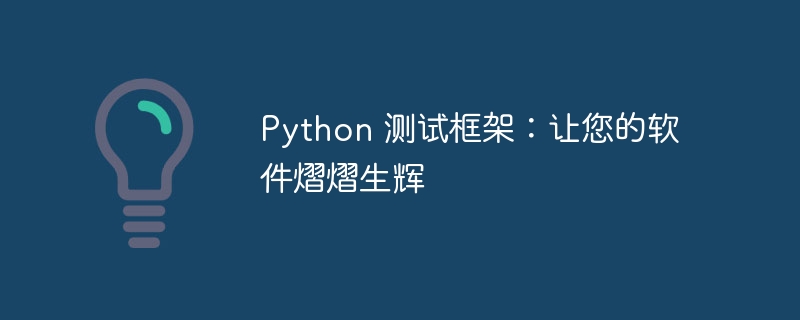Home >Backend Development >Python Tutorial >Python testing framework: Make your software shine
Python testing framework: Make your software shine
- 王林forward
- 2024-04-02 14:16:07899browse

1. Unit testing framework
- unittest: Standard python unittestframework, providing basic functions such as assertions, test cases and test suites.
- pytest: A flexible and feature-rich unit testing framework with a rich plugin ecosystem supporting parameterization, fixtures and reporting.
- nose: An extension framework based on unittest that provides features such as discovery tests, tag-based filtering and output coverage reports.
2. Integration testing framework
- Selenium: A popular WEB automation framework that allows developers to test the user interface of a web application.
- Splinter: A Python friendly web testing framework that supports multiple browser engines, including Firefox and Chrome.
- Robot Framework: A keyword-driven automated testing framework, easy to understand and use, suitable for functional and acceptance testing.
3. End-to-end (E2E) testing framework
- Cypress: An end-to-end testing framework based on node.js that allows developers to view test results in real time in the browser.
- Serenity BDD: An E2E testing framework based on Behavior Driven Development (BDD) that supports natural language syntax and rich reporting capabilities.
- Katalon: A commercial E2E testing platform that provides features such as keyword-based testing, image recognition, and performance testing.
Choose the appropriate testing framework
Selecting an appropriate testing framework depends on the needs of the project and the skills of the team. For simple unit testing, unittest and pytest are good choices. For more complex integration testing, selenium and Splinter provide powerful capabilities. For end-to-end testing, Cypress and Serenity BDD are popular choices.
Best Practices
- Automate all possible scenarios: Automate all test cases as much as possible to ensure that the application functions properly under various conditions.
- Use assertions: Use assertions to verify the expected results of the test and provide meaningful error messages.
- Value readability and maintainability: Write tests that are easy to read and maintain to promote collaboration and rapid debugging.
- Use a test data generator: Consider using a test data generator to create large amounts of test data to fully test your application.
- Leverage CI/CD Tools: Integrate testing into the Continuous Integration and Continuous Delivery (CI/CD) Tools chain to automate the testing process.
in conclusion
By adopting a Python testing framework, developers can significantly improve software quality, reliability, and robustness. By choosing the right framework, following best practices, and leveraging automation tools, teams can ensure their applications run smoothly in the real world.
The above is the detailed content of Python testing framework: Make your software shine. For more information, please follow other related articles on the PHP Chinese website!

